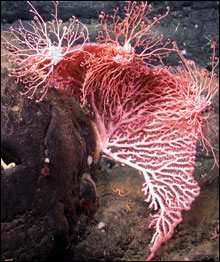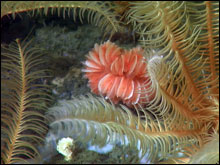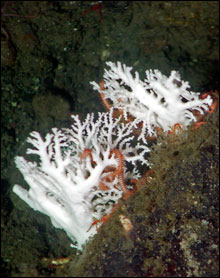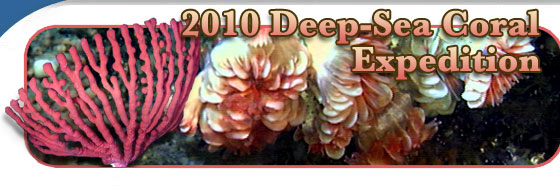Error processing SSI file
|
Deep-Sea Corals and the Changing Chemistry of the Sea
Adrienne Sutton
National Academies Postdoctoral Associate, NOAA Pacific Marine Environmental Laboratory
Most of the ocean is dark and cold. Some organisms have adapted to the extreme conditions of the deep ocean, but the vast majority of marine life exists in the sunlit and relatively thin upper layer of the ocean. At the bottom edge of that thin layer are deep-sea corals. A lesser-known group of coral in comparison to their tropical relatives, deep-sea corals provide habitat that supports rich ecosystems along rocky bottom continental shelves, slopes, and seamounts. Deep-sea corals are diverse, slow-growing, fragile, and have adapted to living at the threshold of the deep sea. However, as the chemistry at this threshold changes, it is uncertain whether deep-sea corals and the ecosystems they support will be able to adapt.
 |
| |
The extreme conditions of the deep sea include a distinctive carbon chemistry that seawater accumulates over an approximately 1000-year journey. This journey begins at the poles where surface ocean waters become cold and dense, and then sink where they merge with deep ocean currents. While traveling at depth throughout the oceans, deep-ocean waters accumulate organic matter (mostly dead plankton) raining down from the surface waters above and the products of respiring that organic matter. Carbon dioxide is one of the products of respiration and reacts with seawater to reduce the pH and the concentration of carbonate ions.
Calcium carbonate minerals are the chemical building blocks of many marine organisms. Shellfish, coral, and many types of plankton all extract calcium carbonate from seawater to form their shells and skeletons. The lack of these building blocks is another important chemical signature of the deep ocean, and we call the depth where this change in chemistry occurs in the ocean the "saturation horizon". Above this saturation horizon, the water is supersaturated with these minerals, meaning it has abundant building blocks for marine organisms to build their skeletons and shells. This is where most deep-sea corals live. Below that horizon, the deep ocean water is undersaturated with these minerals making it more difficult for organisms to build their skeletons and shells, and in some areas of the deep ocean, skeletons and shells dissolve.
 |
| The giant cup coral (Desmophyllum dianthus) amidst the arms of crinoids (Florometra serratissima) (Photo: OCNMS) |
In addition to the natural accumulation of carbon dioxide in the deep ocean, the ocean is now exposed to a new source of carbon dioxide: fossil fuel burning and deforestation. Over the past two and a half centuries, the oceans have absorbed at least a quarter of the carbon dioxide humans have emitted into the atmosphere. The chemical response to carbon dioxide in the surface ocean is the same as in the deep ocean (more carbon dioxide = reduced pH and carbonate ions), and the term given to this response to carbon dioxide emissions is "ocean acidification".
How will ocean acidification impact marine life? There is evidence that the current habitat of shell and skeleton-building organisms, the thin upper layer of the ocean that is supersaturated with calcium carbonate minerals, will shrink as the ocean continues to absorb carbon dioxide from the atmosphere. In other words, the saturation horizon will become shallower. Some models predict that the saturation horizon for aragonite, the form of calcium carbonate deposited by many deep-sea coral to build their skeletons, will reach the surface in large expanses of the ocean by mid-century if fossil fuel emissions continue their current trajectory.
 |
| Living colonies of the hydrocoral Stylaster sp. (Photo: OCNMS) |
Most deep-sea corals already live at the bottom threshold of the saturation horizon, and there are many questions as to how they will be impacted if inundated by undersaturated waters in the future. For example, since most deep-sea corals already live near this threshold, are they exposed to intermittent currents that bring waters undersaturated in calcium carbonate up from the deep ocean? If so, will deep-sea corals possess a natural capacity to adapt to undersaturated waters? Or are deep-sea corals already living at the edge of suitable habitat? And if so, will deep-sea corals struggle to build their calcium carbonate structures as the saturation horizon moves into shallower waters?
The answers to these questions are critical to understanding our deep sea ecosystems and how the services they provide may change over time. With most of the ocean unexplored, it is likely every expedition will bring new discoveries and insights into the lives of deep-sea creatures and how they may respond to impacts from above.
|



